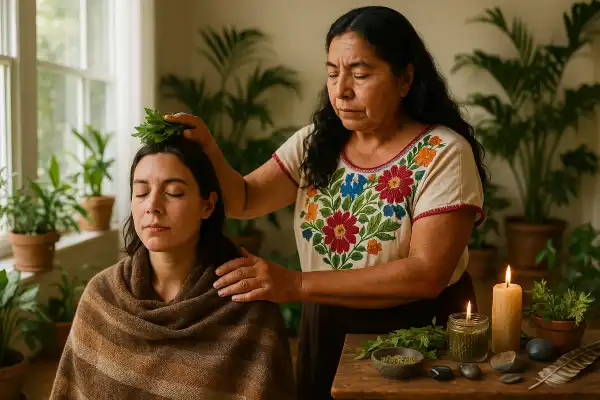What is curanderismo healing and why does this ancient practice continue to call to so many souls seeking balance in our modern world? This question emerges from a deep yearning to understand healing traditions that have sustained Mexican and Mexican American communities for generations, with traditional healing practices reaching as high as 50-75% usage in some parts of the United States.
María del Pilar Fernández understands this calling intimately, having grown up immersed in the sacred knowledge of her curandera lineage in Oaxaca. Through her cultural anthropology training and lifelong practice, she recognizes that people seek answers about curanderismo because they sense something profound yet missing in conventional approaches to wellness—a holistic path that honors the interconnectedness of body, mind, spirit, and community.
For broken hearts, you should read “Can curandera heal heartbroken people?”
What is curanderismo healing?
Curanderismo is a holistic approach to wellness that has been used in the Americas for hundreds of years, representing a synthesis of Mexican indigenous culture and beliefs with influences that may include Catholic, Sephardic, and African traditions depending on the practitioner’s background. This traditional healing system centers around curanderos—healers who come to their vocation through spiritual calling or family lineage, receiving what practitioners believe to be divine knowledge and skills granted by God or a higher power.

The foundations of curanderismo
According to research published in The Western Journal of Medicine, curanderismo demonstrates eight fundamental components that view disease and illness as rooted in emotional imbalance, environmental disharmony, malevolent forces, or spiritual disconnection. These philosophical premises recognize that healing extends far beyond physical symptoms to encompass the entire web of relationships that sustain human life.
The practice emerges from a healing tradition born of the interaction between Indigenous, Spanish, West African, Arab and Asian medicine ways in Mexico more than 500 years ago. Rather than existing as a rigid system with standardized protocols, curanderismo flows as a living tradition passed down orally through generations, adapting to serve each community’s unique needs while maintaining its essential sacred core.
The three levels of healing
Curanderismo operates through three interconnected levels that address the full spectrum of human experience:
The Material Level (Lo Material): This encompasses the physical body and its ailments. Practitioners employ herbal remedies, traditional massages (sobadas), fire cupping (ventosas), treatment of intestinal blockages (empacho), and shawl alignments (manteadas). Plants like aloe vera serve prominently as curatives for skin conditions and digestive support, with modern research confirming their anti-inflammatory and antibiotic properties.
The Mental Level (Lo Mental): This addresses emotional and psychological well-being through counseling conversations (pláticas), the sharing of testimonials, and therapeutic practices that help individuals process trauma and restore mental equilibrium. Practitioners incorporate laugh therapy (terapia de la risa) and other approaches that recognize the profound connection between emotional states and physical health.
The Spiritual Level (Lo Espiritual): This involves prayer and meditation to communicate with spiritual beings including angels, saints, animal protectors, and deities for guidance and spiritual healing power. Some curanderos work in trance states or through dreamtime practices. Spiritual cleansings (limpias) and sweat lodge ceremonies (temazcals) help remove energetic blockages and restore spiritual balance.
Cultural illnesses and holistic treatment
Curanderismo recognizes culture-specific conditions that conventional medicine often overlooks. Susto, for example, represents a form of soul loss similar to PTSD that occurs after traumatic experiences. Other conditions include mal de ojo (evil eye), empacho (blocked intestines), and bilis (anger-induced illness). These diagnoses reflect the tradition’s understanding that illness often originates in spiritual or emotional disruption rather than purely physical causes.
The role of relationship and community
Central to curanderismo’s effectiveness is the sacred relationship between healer and patient. Traditional healers establish strong connections with those they serve, recognizing that healing occurs within the context of trust, cultural understanding, and shared spiritual framework. Family members often participate in healing ceremonies, acknowledging that individual wellness cannot be separated from community health.
Modern integration and recognition
Contemporary curanderas like Grace advocate for thoughtful inclusion of traditional Indigenous healing practices alongside conventional medical treatments, seeking to educate healthcare providers about Mexican Indigenous healing ways. Universities like UNM now offer courses in curanderismo, recognizing its value as a holistic form of traditional medicine that heals body, mind, and spirit.
Research indicates that this integration serves particularly important functions for immigrant communities, helping them maintain essential elements of their culture, beliefs, and identities while providing crucial cultural connection during times of transition.
The calling to heal
The majority of traditional Mexican healers are cisgender women, though practitioners of all genders serve their communities. Many, like Dr. Cheo Torres, describe their path to curanderismo as emerging from childhood experiences with traditional medicine in their families, leading them to seek formal apprenticeships with established healers.
As one practitioner explains, “Curanderismo is an act of stepping out of ourselves and becoming selfless enough to help someone else,” recognizing that healing occurs whenever we extend compassion and presence to another’s suffering.
The resurgence of interest in curanderismo reflects a broader awakening to the limitations of purely biomedical approaches to health. People seeking answers about this tradition often sense an inherent wisdom in practices that have sustained communities through centuries of challenge and change, offering a return to healing approaches that honor the sacred nature of human life and our interconnection with all existence.
Disclaimer
Please note that Maria is not a physician, psychologist, or nurse. These culture-specific spiritual healing services are not meant to replace medical or psychological diagnosis and treatment. It is recommended that you see a licensed physician or licensed health care professional for any physical or psychological ailment you may have.
Maria recalls working with Aurora, a young mother who came to her suffering from persistent headaches and insomnia following a difficult divorce. During their initial consultation, Maria sensed that Aurora’s symptoms stemmed from susto—the spiritual shock that can occur when someone experiences profound loss or betrayal. After creating a sacred space with copal incense and blessed water, Maria performed a traditional limpia, gently brushing Aurora’s energy field with fresh herbs while reciting ancient prayers. She also prepared a personalized herbal tea blend with manzanilla for calm and hierba buena for clarity, instructing Aurora to drink it each evening while setting intentions for healing. Over several sessions that included therapeutic conversations and energy work, Aurora gradually recovered her sense of wholeness. Six months later, she returned to share that not only had her physical symptoms resolved, but she had discovered a new sense of purpose, eventually training to become a doula to support other women through difficult transitions.
